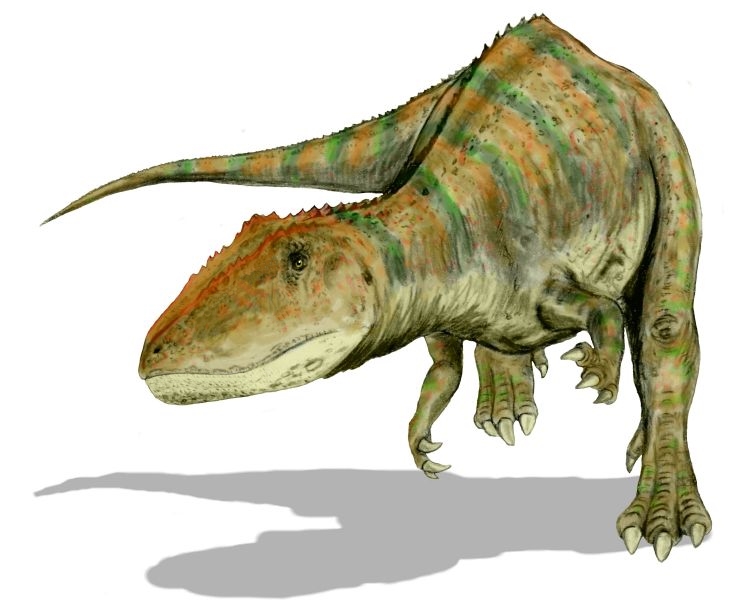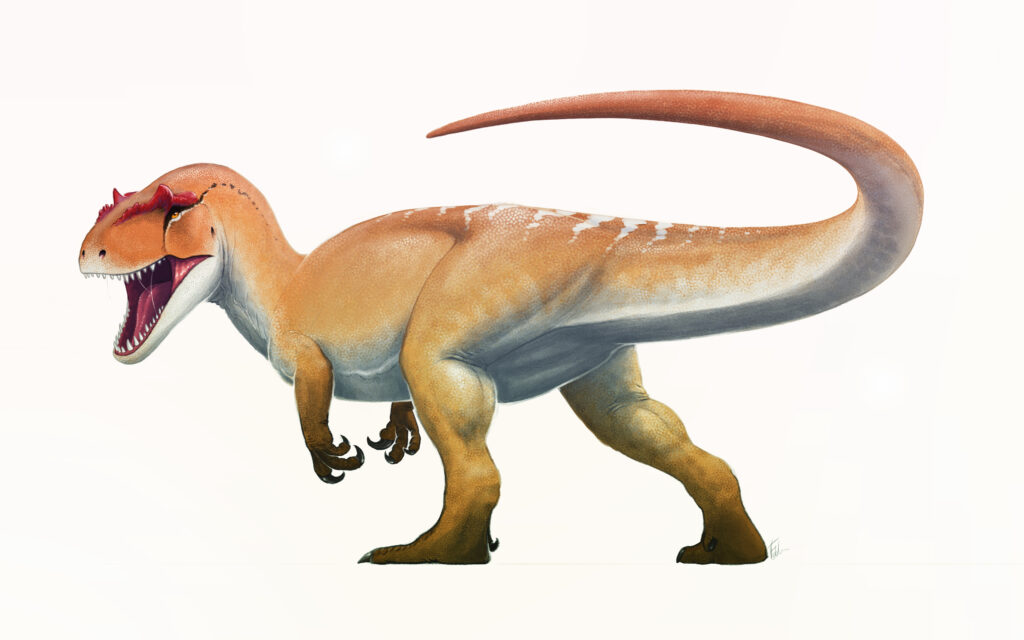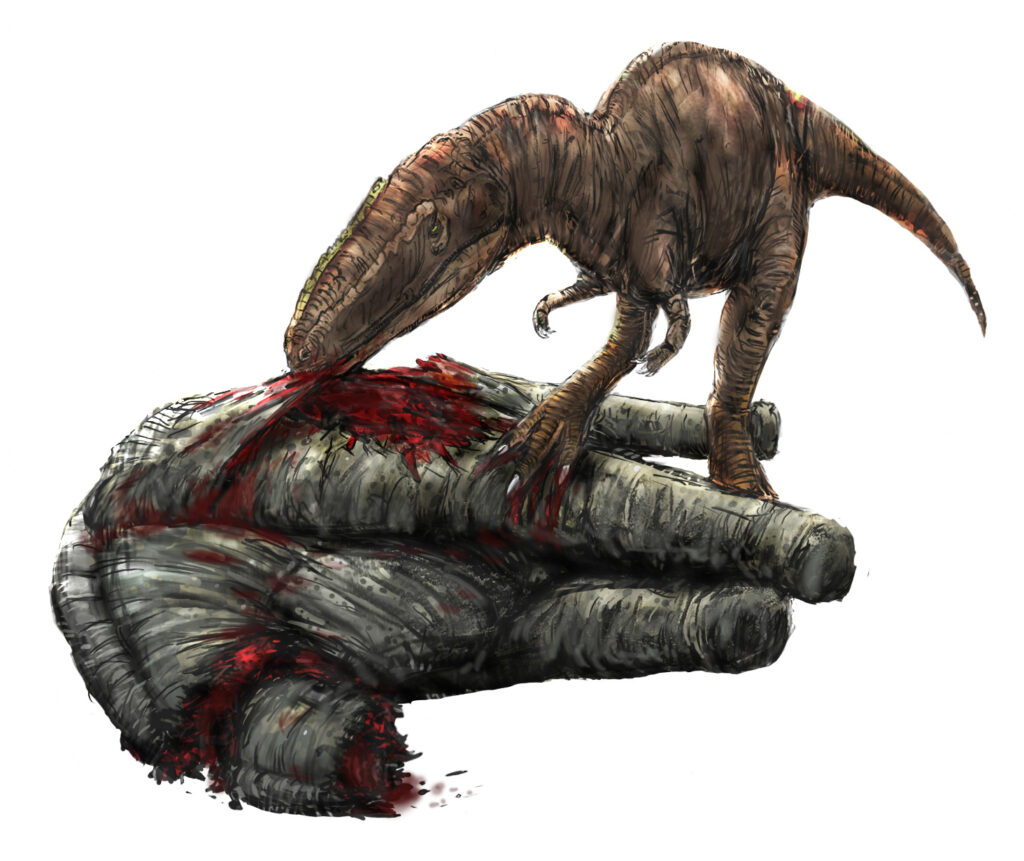When most people think of fearsome prehistoric predators, Tyrannosaurus rex immediately comes to mind. With its massive jaws and intimidating reputation, T. rex has dominated popular culture as the ultimate dinosaur nightmare. However, paleontological discoveries have revealed numerous dinosaurs that could arguably surpass T. rex in terms of terrifying features, hunting abilities, and sheer deadliness. These lesser-known prehistoric monsters possessed unique adaptations that made them equally, if not more, frightening than the famous “tyrant lizard king.” From gigantic sea creatures to massive land predators with specialized killing adaptations, the prehistoric world was filled with creatures that would make even a T. rex seem commonplace by comparison. Let’s explore ten dinosaurs and prehistoric reptiles that might have been even more terrifying than T. rex.
Spinosaurus: The Aquatic Colossus

Spinosaurus aegyptiacus stands as the largest carnivorous dinosaur ever discovered, surpassing even T. rex in size at up to 50-59 feet long. Unlike the land-based T. rex, Spinosaurus was a semi-aquatic predator with adaptations that made it a terrifying hunter in both water and on land. Its most distinctive feature was the massive sail on its back, formed by elongated neural spines, which could have reached over 6 feet tall. Recent fossil evidence has revealed that Spinosaurus had dense bones and a paddle-like tail that helped it swim efficiently, allowing it to hunt large prey in river systems of North Africa during the Cretaceous period. What makes Spinosaurus particularly frightening is its versatility – this massive predator could hunt effectively across multiple environments, giving potential prey fewer safe havens from its enormous crocodile-like jaws filled with conical teeth perfect for snatching slippery fish.
Giganotosaurus: The South American Giant

Giganotosaurus carolinii roamed Argentina approximately 98 million years ago and represents one of the largest terrestrial carnivores ever discovered. Measuring up to 43 feet long and weighing around 8 tons, this theropod may have been slightly larger than T. rex. What made Giganotosaurus particularly terrifying was its combination of size and speed; paleontologists believe it was faster than T. rex due to its lighter build and longer legs. Its skull alone measured over 6 feet long, armed with 8-inch serrated teeth designed for slicing through flesh. Perhaps most intimidating was Giganotosaurus’s hunting strategy – fossil evidence suggests these monsters may have hunted in packs, allowing them to take down enormous sauropods like Argentinosaurus, the largest land animals ever to exist. The prospect of multiple Giganotosaurus coordinating an attack would have been far more terrifying than facing a solitary T. rex.
Carcharodontosaurus: The Shark-Toothed Predator

Carcharodontosaurus saharicus, whose name means “shark-toothed lizard,” earned its moniker from its most fearsome feature – teeth that resembled those of great white sharks. Living in North Africa during the mid-Cretaceous period, this enormous theropod reached lengths similar to T. rex but possessed a longer, narrower skull packed with 8-inch blades designed specifically for causing catastrophic blood loss in prey. Unlike T. rex’s bone-crushing bite, Carcharodontosaurus had a slicing bite technique that would have caused victims to bleed out quickly and efficiently. Recent studies of its brain cavity suggest Carcharodontosaurus had enhanced olfactory abilities, making it an exceptional tracker that could detect prey from great distances. Additionally, this predator lived in extremely harsh environments, demonstrating remarkable adaptability and resilience that would have made it a persistent threat, impossible to escape in its arid habitat.
Mapusaurus: The Pack-Hunting Terror

Mapusaurus roseae represents one of paleontology’s most frightening discoveries – definitive evidence of pack hunting among giant theropods. Discovered in Argentina in a bone bed containing multiple individuals of various ages, Mapusaurus provides strong evidence of social behavior among these 40-foot predators. While individual Mapusaurus were comparable to T. rex in size, their cooperative hunting strategy made them exponentially more dangerous. These pack hunters possessed long, slender legs built for pursuit and slender jaws with serrated teeth designed for inflicting deep, bleeding wounds. Paleontologists believe Mapusaurus packs specifically evolved to hunt massive titanosaur sauropods through coordinated ambush tactics and group attacks. The prospect of multiple 40-foot predators working together, potentially communicating and coordinating their movements, presents a nightmare scenario far more terrifying than encountering a lone T. rex.
Mosasaurus: The Sea Monster

While technically not a dinosaur but a marine reptile, Mosasaurus hoffmannii deserves inclusion for being one of history’s most terrifying predators. Growing up to 56 feet long, this massive sea monster ruled the Late Cretaceous oceans with unparalleled ferocity. Mosasaurus possessed a double-hinged jaw that could swing open widely, allowing it to swallow large prey whole, along with curved teeth designed to trap struggling victims. What made Mosasaurus particularly terrifying was its aquatic agility, powered by a muscular tail and four paddle-like limbs, it could accelerate with tremendous speed to ambush prey. Fossil evidence shows Mosasaurus had a diverse diet including fish, ammonites, seabirds, turtles, and even other marine reptiles. Perhaps most frightening was its likely hunting behavior – modern research suggests Mosasaurus would have employed stealth attacks from below, similar to great white sharks, but on a much larger scale and with even greater power.
Therizinosaurus: The Clawed Nightmare

Therizinosaurus cheloniformis stands as one of the most bizarre and terrifying dinosaurs ever discovered, primarily due to its most distinctive feature – massive forearms ending in three curved claws that could reach over 3 feet in length. These enormous scythe-like claws were the longest of any known animal in history. While paleontologists now believe Therizinosaurus was primarily herbivorous, its appearance would have been utterly terrifying, standing up to 33 feet tall when reaching up with those massive arms. Unlike the relatively small arms of T. rex, Therizinosaurus had immensely powerful forelimbs that could have been used defensively to devastating effect. Its unusual body plan featured a small head, long neck, wide torso, and these enormous claws, creating an almost otherworldly appearance that would have been psychologically terrifying to any predator. Even though it wasn’t primarily a hunter, the defensive capabilities of Therizinosaurus would have made it one of the most dangerous dinosaurs to encounter.
Utahraptor: The Super-Sized Raptor

Utahraptor ostrommaysi represents the largest confirmed dromaeosaur (“raptor”) species, and its capabilities far exceeded those depicted in popular films. Living approximately 125 million years ago, this Early Cretaceous predator reached lengths of 23 feet and weights over 1,100 pounds – far larger than its famous cousin Velociraptor. What made Utahraptor truly frightening was the combination of its size with the specialized killing adaptations of dromaeosaurs. Each foot possessed an enlarged, sickle-shaped claw nearly 9 inches long that functioned as a precise disemboweling weapon. Unlike T. rex, which was relatively slow and relied on ambush, Utahraptor combined significant size with agility and pack-hunting behavior. Fossil evidence suggests these predators worked in coordinated groups, using their powerful legs to kick and slash at larger prey while using their forelimbs to grip onto victims. Their binocular vision, enlarged brain, and likely advanced social behavior would have made them exceptionally intelligent hunters, far more sophisticated in their killing techniques than the more straightforward T. rex.
Deinosuchus: The Terror Crocodile

Another non-dinosaur that demands inclusion is Deinosuchus riograndensis, an ancient relative of modern crocodilians that reached truly monstrous proportions. Living between 82-73 million years ago, Deinosuchus grew to lengths of 33-39 feet and weighed up to 8.5 tons, with a skull alone measuring nearly 6 feet long. Unlike T. rex, which was a specialized terrestrial predator, Deinosuchus was a master of the ambush, capable of dragging even large dinosaurs to their death at the water’s edge. Fossil evidence confirms that these massive crocodilians preyed upon dinosaurs, with distinctive bite marks found on dinosaur bones. Deinosuchus had immensely powerful jaws that could exert over 23,000 pounds of force, more than twice the bite force estimated for T. rex. What makes Deinosuchus particularly frightening is that it combined this devastating bite with the patient, stealthy hunting strategy of modern crocodiles, but at a scale that could bring down even armored dinosaurs.
Dakotaraptor: The Agile Giant

Dakotaraptor steini represented a perfect balance of size and agility that made it an exceptionally effective killer. Discovered in South Dakota and dating to the very end of the Cretaceous period, Dakotaraptor reached lengths of 16-17 feet, placing it among the largest dromaeosaurs ever discovered. What made Dakotaraptor particularly frightening was how it combined the killing adaptations of smaller raptors with significant size and power. Its hind limbs featured the classic enlarged sickle claw, measuring 9.5 inches along its outer curve, while its forelimbs possessed significant quill knobs indicating the presence of feathers that may have aided in hunting. Biomechanical studies suggest Dakotaraptor could run at speeds of up to 33 mph, significantly faster than T. rex, while retaining the precise, calculated hunting tactics associated with dromaeosaurs. Most frightening was its likely hunting behavior – Dakotaraptor could pursue prey at high speeds, using its wings for balance while leaping onto victims’ backs and using its weight combined with those massive talons to inflict fatal wounds.
Allosaurus: The Perfect Predatory Machine

Allosaurus fragilis predated T. rex by over 80 million years, but in many ways, it represented a more refined killing machine. Living during the Late Jurassic period, Allosaurus reached lengths of 28-33 feet and possessed a unique set of adaptations that made it an exceptionally effective predator. Unlike T. rex’s crushing bite, Allosaurus had a more surgical approach to killing, using its jaws like a hatchet to inflict deep, precise wounds with serrated teeth. Its skull contained shock-absorbing features that allowed for a unique feeding strategy of pulling upward with its powerful neck muscles while its teeth sliced through flesh. Most terrifying was Allosaurus’s remarkable adaptation of a double-hinged jaw that could open extraordinarily wide, combined with flexible skull joints that allowed it to swallow massive chunks of meat. Fossil evidence indicates Allosaurus targeted even the largest sauropods of its time, potentially hunting in loose packs to bring down prey many times their size through strategic attacks aimed at causing blood loss rather than immediate kills.
Tyrannotitan: The Forgotten Nightmare

Tyrannotitan chubutensis represents one of the lesser-known but most terrifying predators of the middle Cretaceous period. This massive carcharodontosaurid roamed what is now Argentina approximately 115 million years ago, reaching estimated lengths of 41 feet and weighing up to 7 tons. What made Tyrannotitan particularly frightening was its specialized predatory adaptations, including exceptionally long, blade-like teeth designed specifically for slicing through the tough hides of the massive titanosaur sauropods that shared its environment. Its skull structure suggests a bite optimized for causing catastrophic blood loss rather than the bone-crushing bite of T. rex. Paleontological evidence indicates Tyrannotitan had particularly powerful leg muscles and a streamlined body that allowed for surprising bursts of speed despite its size. Most intimidating was Tyrannotitan’s environmental dominance – fossil evidence suggests it was the apex predator in an ecosystem filled with some of the largest dinosaurs ever to exist, indicating hunting capabilities that allowed it to target prey that would have dwarfed even adult T. rex.
Why These Dinosaurs Surpassed T. rex in Terror

While T. rex certainly deserves its fearsome reputation, these alternative prehistoric monsters demonstrate why the king of the dinosaurs wasn’t necessarily the most terrifying. Many of these predators possessed specialized adaptations that made them more efficient killers in their respective environments. The pack-hunting behavior evident in Mapusaurus and Utahraptor represents a level of social coordination and hunting sophistication that T. rex likely lacked. The aquatic adaptations of creatures like Spinosaurus and Mosasaurus allowed them to dominate environments completely inaccessible to T. rex. Several of these predators, including Giganotosaurus and Tyrannotitan, simply outclassed T. rex in terms of size and likely hunting capabilities. Most importantly, these diverse predators remind us that the prehistoric world contained numerous ecological niches filled by specialized killers, each evolved to be perfectly suited to their environments and prey. While T. rex remains paleontology’s most famous predator, these ten alternatives demonstrate the incredible diversity of terrifying adaptations that evolved throughout the Mesozoic era.
Conclusion

The prehistoric world was filled with predators that rivaled and often surpassed Tyrannosaurus rex in terms of size, hunting adaptations, and sheer terror factor. From the semi-aquatic Spinosaurus with its massive sail to the pack-hunting Mapusaurus that coordinated attacks on massive prey, these ancient monsters employed diverse and specialized killing strategies that made them exceptionally effective predators. While T. rex maintains its well-deserved place in the popular imagination, paleontological discoveries continue to reveal new insights about these lesser-known but equally frightening prehistoric creatures. What becomes clear is that the Mesozoic era was dominated not by a single apex predator but by a succession of perfectly adapted killing machines, each evolved to thrive in their specific time and environment. These ten examples represent just a fraction of the diverse and terrifying predators that once ruled Earth, reminding us that the prehistoric world was a far more dangerous place than even our most frightening dinosaur movies might suggest.



